Biology: Stem Cell Use in Organ Generation and Transplantation
VerifiedAdded on 2023/04/08
|10
|2071
|99
Report
AI Summary
This report explores the potential of stem cells in organ generation to address the critical shortage of donor organs. It discusses the use of stem cells, including embryonic and adult stem cells, in creating organs in the lab. The report highlights the importance of scaffolds and bio chambers in nurturing cells and the challenges involved, such as ensuring proper vascularization and cell differentiation. The research also examines the use of adult tissue stem cells, particularly from mammary glands, and their ability to generate functional mammary glands in vivo. The report concludes that stem cell therapy holds promise for treating various diseases and underscores the need for further research to discover new sources of healthy tissues for organ generation. Desklib provides access to this and other solved assignments for students.
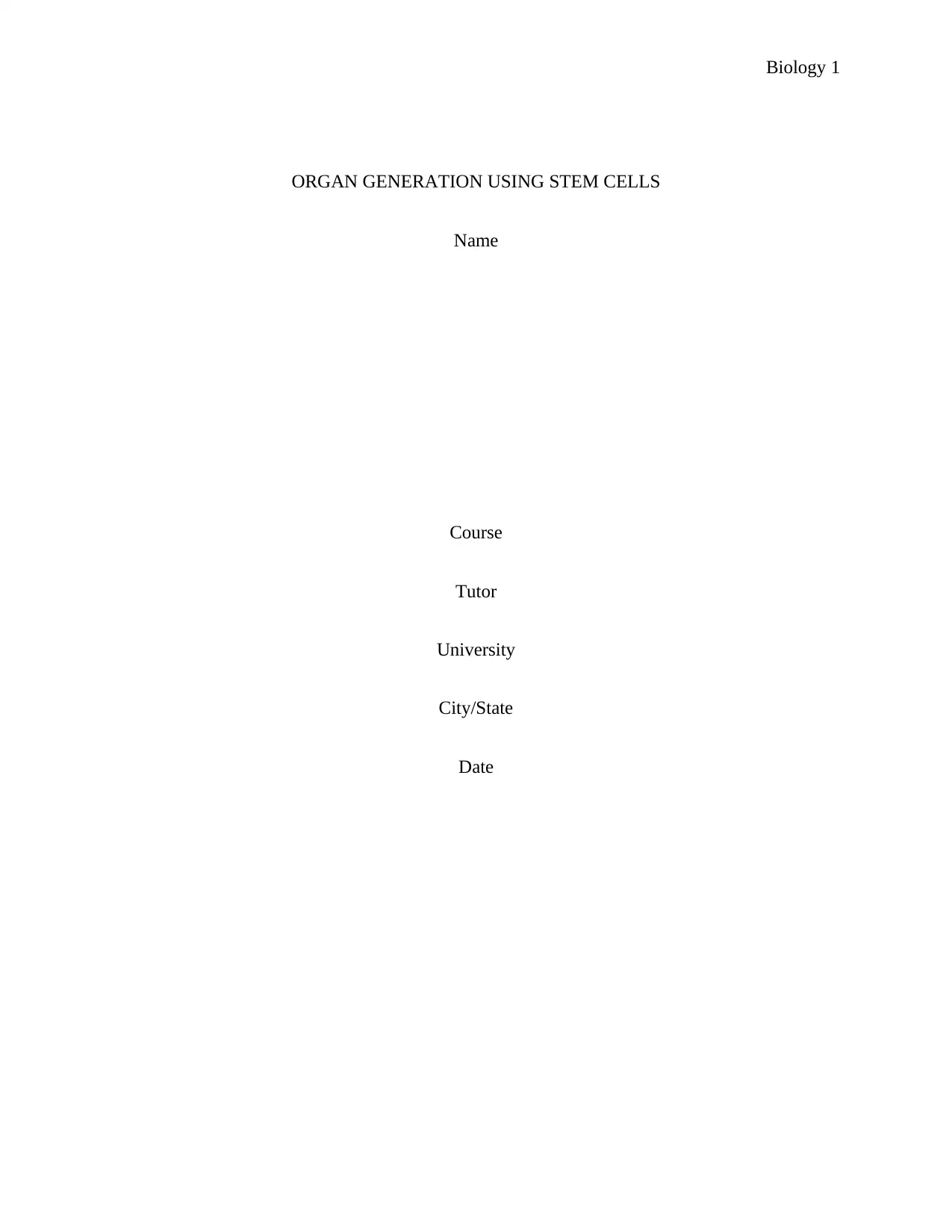
Biology 1
ORGAN GENERATION USING STEM CELLS
Name
Course
Tutor
University
City/State
Date
ORGAN GENERATION USING STEM CELLS
Name
Course
Tutor
University
City/State
Date
Paraphrase This Document
Need a fresh take? Get an instant paraphrase of this document with our AI Paraphraser
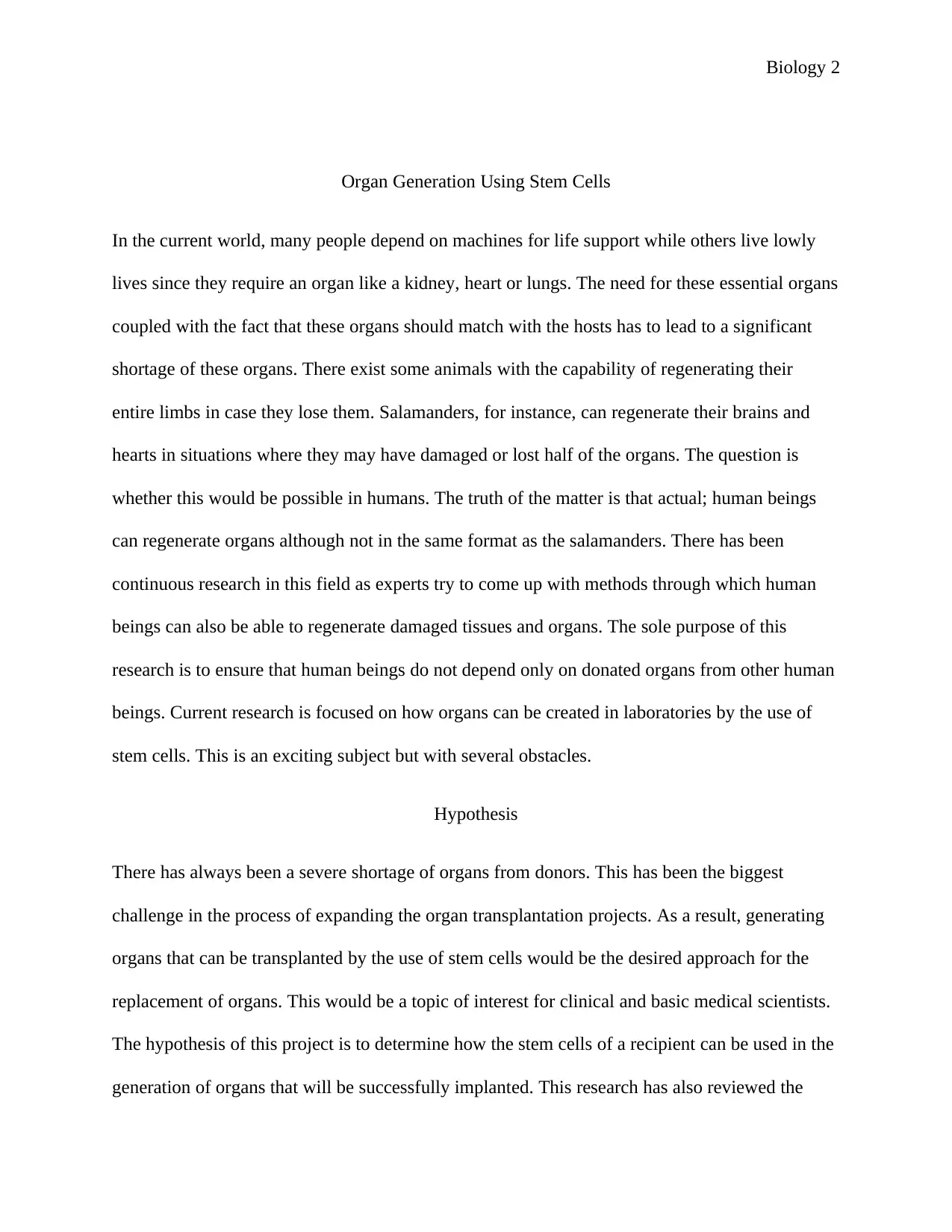
Biology 2
Organ Generation Using Stem Cells
In the current world, many people depend on machines for life support while others live lowly
lives since they require an organ like a kidney, heart or lungs. The need for these essential organs
coupled with the fact that these organs should match with the hosts has to lead to a significant
shortage of these organs. There exist some animals with the capability of regenerating their
entire limbs in case they lose them. Salamanders, for instance, can regenerate their brains and
hearts in situations where they may have damaged or lost half of the organs. The question is
whether this would be possible in humans. The truth of the matter is that actual; human beings
can regenerate organs although not in the same format as the salamanders. There has been
continuous research in this field as experts try to come up with methods through which human
beings can also be able to regenerate damaged tissues and organs. The sole purpose of this
research is to ensure that human beings do not depend only on donated organs from other human
beings. Current research is focused on how organs can be created in laboratories by the use of
stem cells. This is an exciting subject but with several obstacles.
Hypothesis
There has always been a severe shortage of organs from donors. This has been the biggest
challenge in the process of expanding the organ transplantation projects. As a result, generating
organs that can be transplanted by the use of stem cells would be the desired approach for the
replacement of organs. This would be a topic of interest for clinical and basic medical scientists.
The hypothesis of this project is to determine how the stem cells of a recipient can be used in the
generation of organs that will be successfully implanted. This research has also reviewed the
Organ Generation Using Stem Cells
In the current world, many people depend on machines for life support while others live lowly
lives since they require an organ like a kidney, heart or lungs. The need for these essential organs
coupled with the fact that these organs should match with the hosts has to lead to a significant
shortage of these organs. There exist some animals with the capability of regenerating their
entire limbs in case they lose them. Salamanders, for instance, can regenerate their brains and
hearts in situations where they may have damaged or lost half of the organs. The question is
whether this would be possible in humans. The truth of the matter is that actual; human beings
can regenerate organs although not in the same format as the salamanders. There has been
continuous research in this field as experts try to come up with methods through which human
beings can also be able to regenerate damaged tissues and organs. The sole purpose of this
research is to ensure that human beings do not depend only on donated organs from other human
beings. Current research is focused on how organs can be created in laboratories by the use of
stem cells. This is an exciting subject but with several obstacles.
Hypothesis
There has always been a severe shortage of organs from donors. This has been the biggest
challenge in the process of expanding the organ transplantation projects. As a result, generating
organs that can be transplanted by the use of stem cells would be the desired approach for the
replacement of organs. This would be a topic of interest for clinical and basic medical scientists.
The hypothesis of this project is to determine how the stem cells of a recipient can be used in the
generation of organs that will be successfully implanted. This research has also reviewed the

Biology 3
current progress in this field of generating organs by the use of stem cells via the method of
single adult tissue stem cells (Wagner et al. 2013, 12).
Introduction
The process of creating human organs requires a lot of things and procedures to be considered
and put together to come up with the desired organ for transplant. Firstly, a scaffold is necessary
so that the cells of the desired organ are nurtured. Upon maturity, these cells are then harvested
through various methods based on the organ that is being generated. Simple organs like the
bladders allow biopsies to be collected and then the urothelial cells are multiplied in vitro. The
biopsy, however, requires quite a significant sample almost the size of a stamp which makes the
process complex in cases that involve sensitive organs like the heart since a small miscalculation
could lead to lethal effects on the patients and even death. In such cases, the use of stem cells
becomes vital since they can be differentiated into the cell types desired (Tapias and Ott 2014, p.
56).
A bio chamber is used to house the scaffold and the stem cells when they become ready
or mature. The stem cells are then applied to the framework through various methods based on
the organ being generated. For instance, the skin usually needs the stem cells to grow in
relatively easy layers. On the other hand, an organ like the heart of the liver is highly
vascularized and therefore requires the stem cells to be distributed throughout the entire organs
as opposed to some specific parts. To do this process successfully, own modifications and
demands are done on the scaffold including but not limited to ensuring that the platform is
biodegradable as well as richly vascularized as researched by Van Poll et al. (2008). This is a
complex process since the thickness of the tissue should be thick enough to ensure there is
current progress in this field of generating organs by the use of stem cells via the method of
single adult tissue stem cells (Wagner et al. 2013, 12).
Introduction
The process of creating human organs requires a lot of things and procedures to be considered
and put together to come up with the desired organ for transplant. Firstly, a scaffold is necessary
so that the cells of the desired organ are nurtured. Upon maturity, these cells are then harvested
through various methods based on the organ that is being generated. Simple organs like the
bladders allow biopsies to be collected and then the urothelial cells are multiplied in vitro. The
biopsy, however, requires quite a significant sample almost the size of a stamp which makes the
process complex in cases that involve sensitive organs like the heart since a small miscalculation
could lead to lethal effects on the patients and even death. In such cases, the use of stem cells
becomes vital since they can be differentiated into the cell types desired (Tapias and Ott 2014, p.
56).
A bio chamber is used to house the scaffold and the stem cells when they become ready
or mature. The stem cells are then applied to the framework through various methods based on
the organ being generated. For instance, the skin usually needs the stem cells to grow in
relatively easy layers. On the other hand, an organ like the heart of the liver is highly
vascularized and therefore requires the stem cells to be distributed throughout the entire organs
as opposed to some specific parts. To do this process successfully, own modifications and
demands are done on the scaffold including but not limited to ensuring that the platform is
biodegradable as well as richly vascularized as researched by Van Poll et al. (2008). This is a
complex process since the thickness of the tissue should be thick enough to ensure there is
⊘ This is a preview!⊘
Do you want full access?
Subscribe today to unlock all pages.

Trusted by 1+ million students worldwide
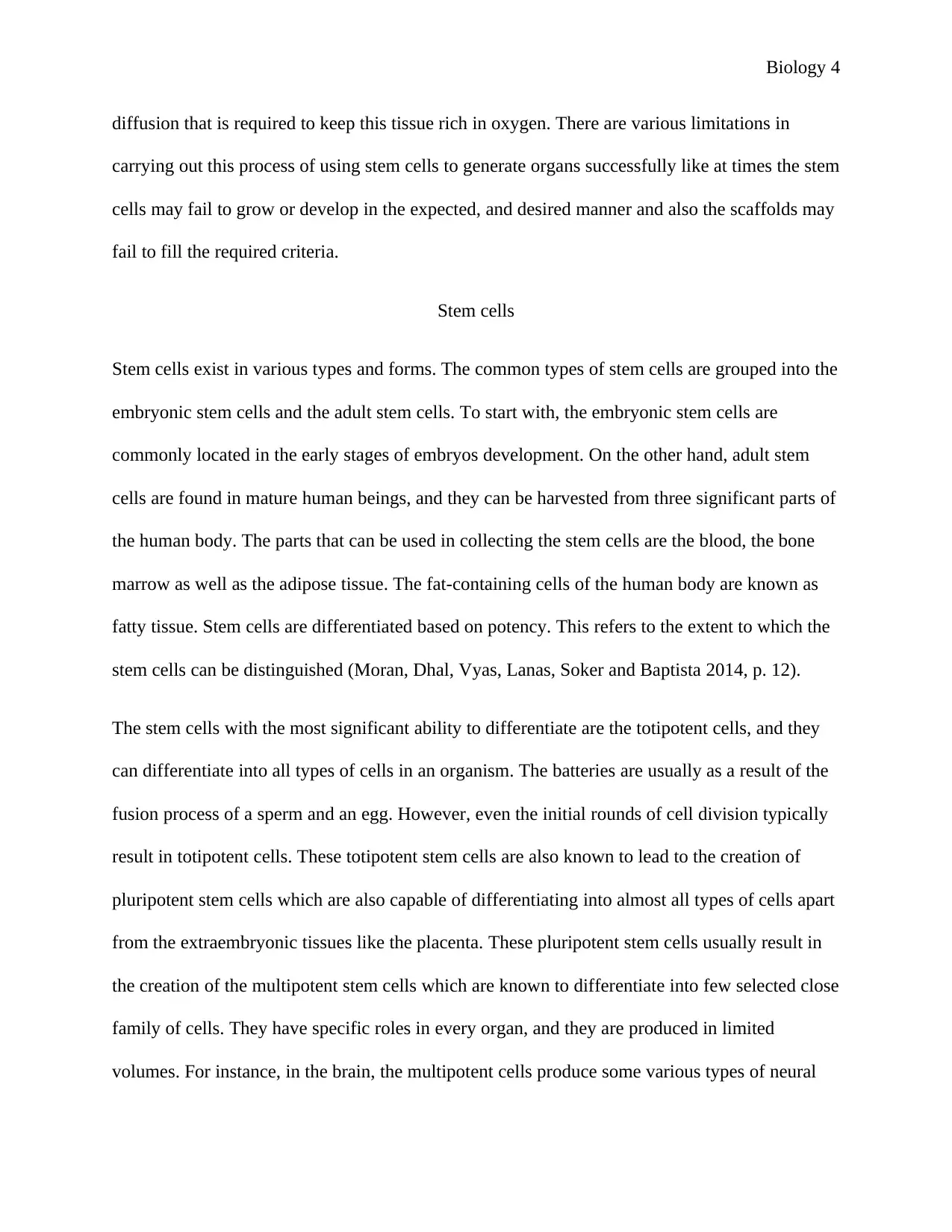
Biology 4
diffusion that is required to keep this tissue rich in oxygen. There are various limitations in
carrying out this process of using stem cells to generate organs successfully like at times the stem
cells may fail to grow or develop in the expected, and desired manner and also the scaffolds may
fail to fill the required criteria.
Stem cells
Stem cells exist in various types and forms. The common types of stem cells are grouped into the
embryonic stem cells and the adult stem cells. To start with, the embryonic stem cells are
commonly located in the early stages of embryos development. On the other hand, adult stem
cells are found in mature human beings, and they can be harvested from three significant parts of
the human body. The parts that can be used in collecting the stem cells are the blood, the bone
marrow as well as the adipose tissue. The fat-containing cells of the human body are known as
fatty tissue. Stem cells are differentiated based on potency. This refers to the extent to which the
stem cells can be distinguished (Moran, Dhal, Vyas, Lanas, Soker and Baptista 2014, p. 12).
The stem cells with the most significant ability to differentiate are the totipotent cells, and they
can differentiate into all types of cells in an organism. The batteries are usually as a result of the
fusion process of a sperm and an egg. However, even the initial rounds of cell division typically
result in totipotent cells. These totipotent stem cells are also known to lead to the creation of
pluripotent stem cells which are also capable of differentiating into almost all types of cells apart
from the extraembryonic tissues like the placenta. These pluripotent stem cells usually result in
the creation of the multipotent stem cells which are known to differentiate into few selected close
family of cells. They have specific roles in every organ, and they are produced in limited
volumes. For instance, in the brain, the multipotent cells produce some various types of neural
diffusion that is required to keep this tissue rich in oxygen. There are various limitations in
carrying out this process of using stem cells to generate organs successfully like at times the stem
cells may fail to grow or develop in the expected, and desired manner and also the scaffolds may
fail to fill the required criteria.
Stem cells
Stem cells exist in various types and forms. The common types of stem cells are grouped into the
embryonic stem cells and the adult stem cells. To start with, the embryonic stem cells are
commonly located in the early stages of embryos development. On the other hand, adult stem
cells are found in mature human beings, and they can be harvested from three significant parts of
the human body. The parts that can be used in collecting the stem cells are the blood, the bone
marrow as well as the adipose tissue. The fat-containing cells of the human body are known as
fatty tissue. Stem cells are differentiated based on potency. This refers to the extent to which the
stem cells can be distinguished (Moran, Dhal, Vyas, Lanas, Soker and Baptista 2014, p. 12).
The stem cells with the most significant ability to differentiate are the totipotent cells, and they
can differentiate into all types of cells in an organism. The batteries are usually as a result of the
fusion process of a sperm and an egg. However, even the initial rounds of cell division typically
result in totipotent cells. These totipotent stem cells are also known to lead to the creation of
pluripotent stem cells which are also capable of differentiating into almost all types of cells apart
from the extraembryonic tissues like the placenta. These pluripotent stem cells usually result in
the creation of the multipotent stem cells which are known to differentiate into few selected close
family of cells. They have specific roles in every organ, and they are produced in limited
volumes. For instance, in the brain, the multipotent cells produce some various types of neural
Paraphrase This Document
Need a fresh take? Get an instant paraphrase of this document with our AI Paraphraser
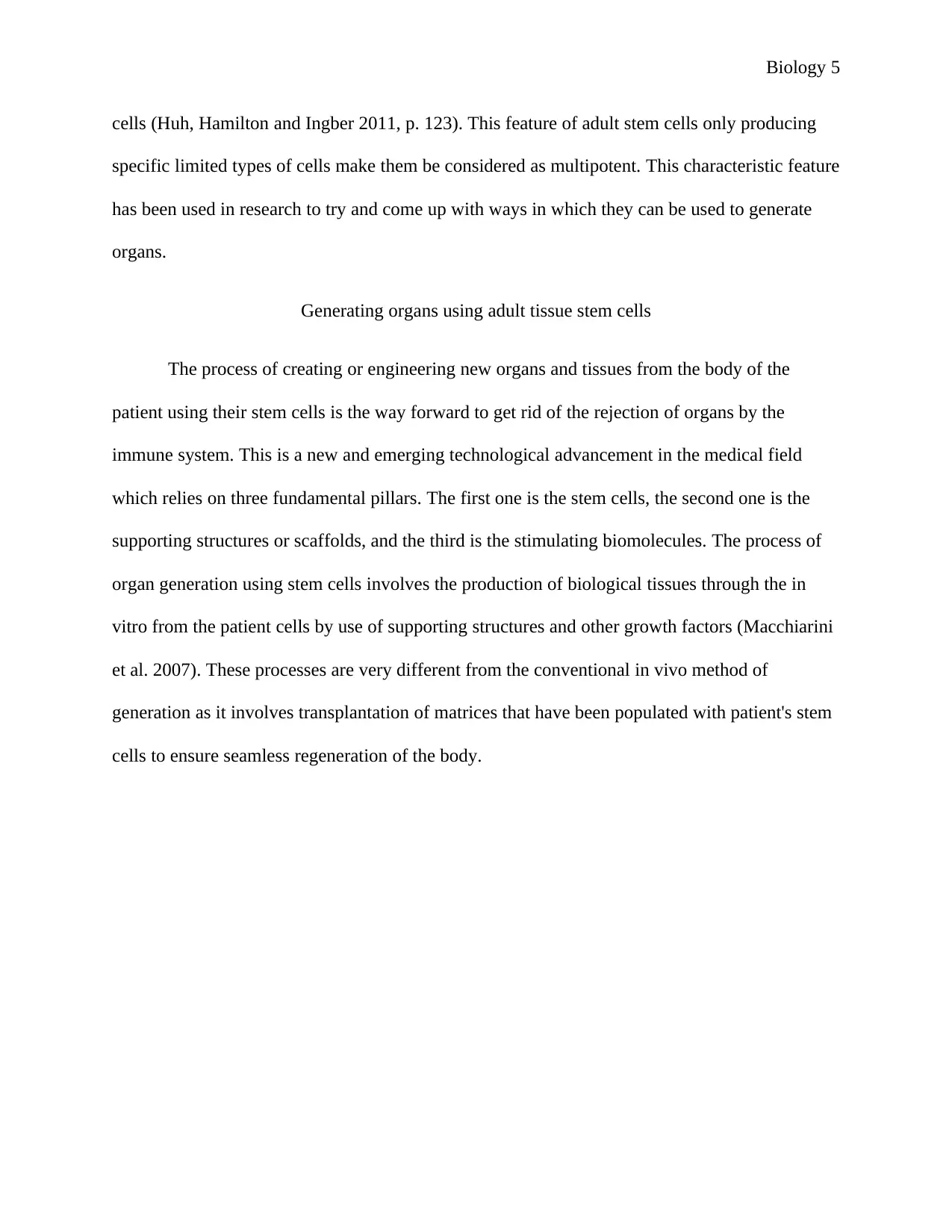
Biology 5
cells (Huh, Hamilton and Ingber 2011, p. 123). This feature of adult stem cells only producing
specific limited types of cells make them be considered as multipotent. This characteristic feature
has been used in research to try and come up with ways in which they can be used to generate
organs.
Generating organs using adult tissue stem cells
The process of creating or engineering new organs and tissues from the body of the
patient using their stem cells is the way forward to get rid of the rejection of organs by the
immune system. This is a new and emerging technological advancement in the medical field
which relies on three fundamental pillars. The first one is the stem cells, the second one is the
supporting structures or scaffolds, and the third is the stimulating biomolecules. The process of
organ generation using stem cells involves the production of biological tissues through the in
vitro from the patient cells by use of supporting structures and other growth factors (Macchiarini
et al. 2007). These processes are very different from the conventional in vivo method of
generation as it involves transplantation of matrices that have been populated with patient's stem
cells to ensure seamless regeneration of the body.
cells (Huh, Hamilton and Ingber 2011, p. 123). This feature of adult stem cells only producing
specific limited types of cells make them be considered as multipotent. This characteristic feature
has been used in research to try and come up with ways in which they can be used to generate
organs.
Generating organs using adult tissue stem cells
The process of creating or engineering new organs and tissues from the body of the
patient using their stem cells is the way forward to get rid of the rejection of organs by the
immune system. This is a new and emerging technological advancement in the medical field
which relies on three fundamental pillars. The first one is the stem cells, the second one is the
supporting structures or scaffolds, and the third is the stimulating biomolecules. The process of
organ generation using stem cells involves the production of biological tissues through the in
vitro from the patient cells by use of supporting structures and other growth factors (Macchiarini
et al. 2007). These processes are very different from the conventional in vivo method of
generation as it involves transplantation of matrices that have been populated with patient's stem
cells to ensure seamless regeneration of the body.

Biology 6
Popp did research et al. (2018) and Perin et al. (2018) in labs and have shown that a single stem
cell which has been isolated from the mammary glands of an adult mouse was able to produce
secretory mammary glands after they were transplanted into the fat pad in the mouse. Stem cells
are believed to be found in mammary glands because these organs usually grow extensively
during puberty as well as during the second phase of growth at pregnancy being regulated by
estrogen. The challenge of the lack of clear markers has made it impossible to develop a reliable
way of isolating the mammary stem cells. However, based on previous research works and
findings done by Clark where they separated the mammary stem cells of a putative mouse by use
of specified cell surface markers that is (Lin-, CD29hi, CD24+) by FACS. The scientists were
able to demonstrate that the Lin-CD29hiCD24+ mammary cells contain the capability of in vitro
sphere formation, as well as the capacity, populate all the epithelial cells of the mammary glands
Popp did research et al. (2018) and Perin et al. (2018) in labs and have shown that a single stem
cell which has been isolated from the mammary glands of an adult mouse was able to produce
secretory mammary glands after they were transplanted into the fat pad in the mouse. Stem cells
are believed to be found in mammary glands because these organs usually grow extensively
during puberty as well as during the second phase of growth at pregnancy being regulated by
estrogen. The challenge of the lack of clear markers has made it impossible to develop a reliable
way of isolating the mammary stem cells. However, based on previous research works and
findings done by Clark where they separated the mammary stem cells of a putative mouse by use
of specified cell surface markers that is (Lin-, CD29hi, CD24+) by FACS. The scientists were
able to demonstrate that the Lin-CD29hiCD24+ mammary cells contain the capability of in vitro
sphere formation, as well as the capacity, populate all the epithelial cells of the mammary glands
⊘ This is a preview!⊘
Do you want full access?
Subscribe today to unlock all pages.

Trusted by 1+ million students worldwide

Biology 7
again after they had been transplanted into the fat pad. This research further supports our
hypothesis of organ generation through stem cells since the researchers had used a lineage tracer
in the mammary stem cells to ensure they followed their ultimate phenotypes in vivo (Gamborg
and Phillips 2013, p. 34)
The findings clearly and elegantly show that adult stem cells that are in the population range of
Lin-CD29hiCD24+ of the mammary glands when marked with LacZ report transgenes can
reconstitute fully independent and functional mammary glands in vivo. It is also good to note
that when the stem cells are transplanted, they contribute to the luminal as well as the
myoepithelial linings by also generating the lobuloalveolar units which produce milk during
pregnancy period. This research has further confirmed that a single adult tissue stem cell can
have several lineage capacities to differentiate to produce an organ that is functional in an in vivo
setup.
According to Oshima, et al. (2017), the use of adult stem cells in organ generation like the tissue
epithelial stem cells has a lower risk of tumorigenesis. Besides, the use of adult stem cells in
organ generation enhances a better selection process of differentiation capacity and improved
method of integrating the stem cells into the desired tissue mass as well as acquiring the needed
organ functions. The limiting factor is, however, the number of adult tissue cells which can be
isolated since it is a complicated procedure that is also dependent on the DNA structure of the
recipient. The positive news, however, is that this stem cell therapy has promised great results
and impact in treating some diseases like stroke, Alzheimer's disease, traumatic brain injury,
diabetes, amyotrophic lateral sclerosis, Parkinson's disease, myocardial infarctions, muscle
dystrophy, among others. The research findings further answer and address the critical questions
in the hypothesis about the biological and therapeutic ability of human adult stem cells, the
again after they had been transplanted into the fat pad. This research further supports our
hypothesis of organ generation through stem cells since the researchers had used a lineage tracer
in the mammary stem cells to ensure they followed their ultimate phenotypes in vivo (Gamborg
and Phillips 2013, p. 34)
The findings clearly and elegantly show that adult stem cells that are in the population range of
Lin-CD29hiCD24+ of the mammary glands when marked with LacZ report transgenes can
reconstitute fully independent and functional mammary glands in vivo. It is also good to note
that when the stem cells are transplanted, they contribute to the luminal as well as the
myoepithelial linings by also generating the lobuloalveolar units which produce milk during
pregnancy period. This research has further confirmed that a single adult tissue stem cell can
have several lineage capacities to differentiate to produce an organ that is functional in an in vivo
setup.
According to Oshima, et al. (2017), the use of adult stem cells in organ generation like the tissue
epithelial stem cells has a lower risk of tumorigenesis. Besides, the use of adult stem cells in
organ generation enhances a better selection process of differentiation capacity and improved
method of integrating the stem cells into the desired tissue mass as well as acquiring the needed
organ functions. The limiting factor is, however, the number of adult tissue cells which can be
isolated since it is a complicated procedure that is also dependent on the DNA structure of the
recipient. The positive news, however, is that this stem cell therapy has promised great results
and impact in treating some diseases like stroke, Alzheimer's disease, traumatic brain injury,
diabetes, amyotrophic lateral sclerosis, Parkinson's disease, myocardial infarctions, muscle
dystrophy, among others. The research findings further answer and address the critical questions
in the hypothesis about the biological and therapeutic ability of human adult stem cells, the
Paraphrase This Document
Need a fresh take? Get an instant paraphrase of this document with our AI Paraphraser
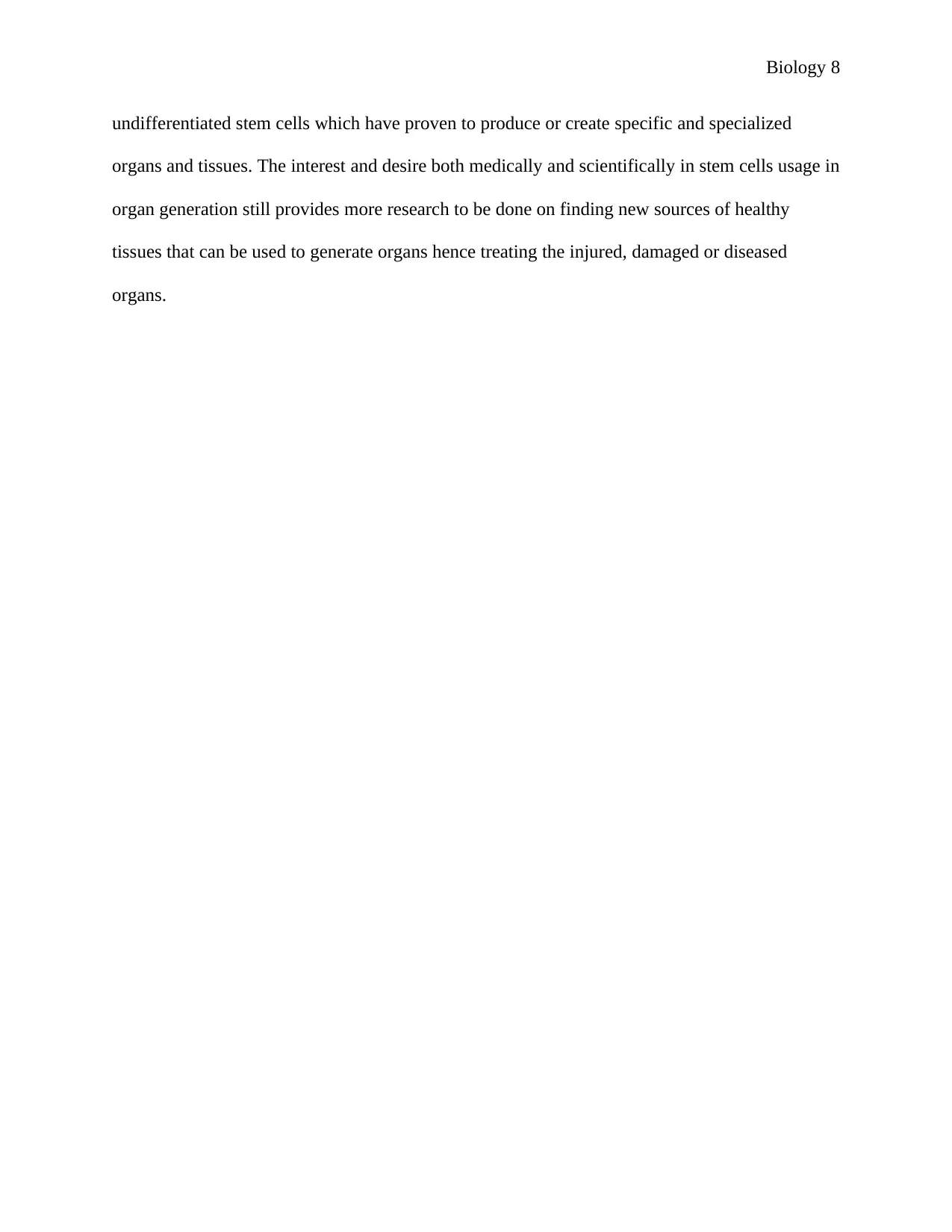
Biology 8
undifferentiated stem cells which have proven to produce or create specific and specialized
organs and tissues. The interest and desire both medically and scientifically in stem cells usage in
organ generation still provides more research to be done on finding new sources of healthy
tissues that can be used to generate organs hence treating the injured, damaged or diseased
organs.
undifferentiated stem cells which have proven to produce or create specific and specialized
organs and tissues. The interest and desire both medically and scientifically in stem cells usage in
organ generation still provides more research to be done on finding new sources of healthy
tissues that can be used to generate organs hence treating the injured, damaged or diseased
organs.
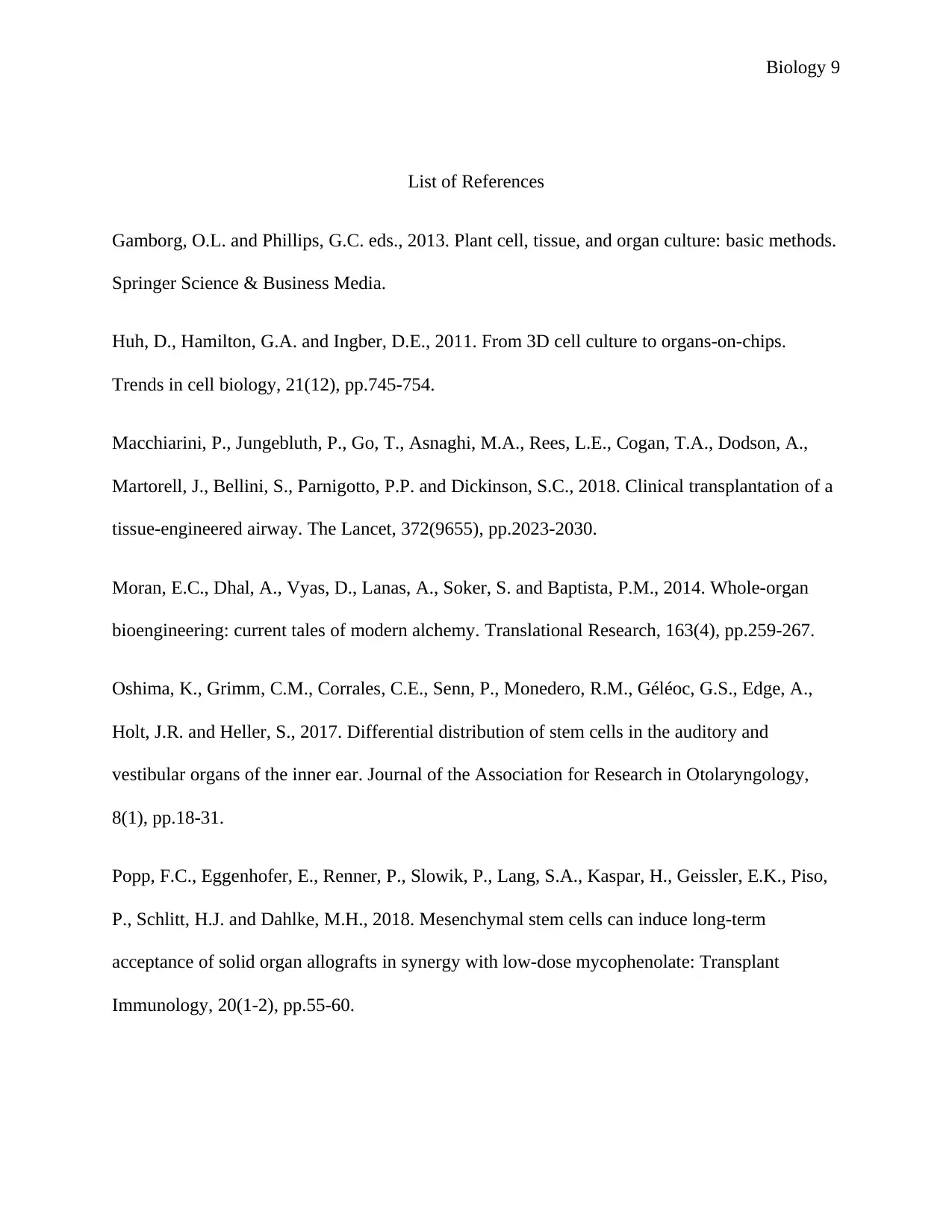
Biology 9
List of References
Gamborg, O.L. and Phillips, G.C. eds., 2013. Plant cell, tissue, and organ culture: basic methods.
Springer Science & Business Media.
Huh, D., Hamilton, G.A. and Ingber, D.E., 2011. From 3D cell culture to organs-on-chips.
Trends in cell biology, 21(12), pp.745-754.
Macchiarini, P., Jungebluth, P., Go, T., Asnaghi, M.A., Rees, L.E., Cogan, T.A., Dodson, A.,
Martorell, J., Bellini, S., Parnigotto, P.P. and Dickinson, S.C., 2018. Clinical transplantation of a
tissue-engineered airway. The Lancet, 372(9655), pp.2023-2030.
Moran, E.C., Dhal, A., Vyas, D., Lanas, A., Soker, S. and Baptista, P.M., 2014. Whole-organ
bioengineering: current tales of modern alchemy. Translational Research, 163(4), pp.259-267.
Oshima, K., Grimm, C.M., Corrales, C.E., Senn, P., Monedero, R.M., Géléoc, G.S., Edge, A.,
Holt, J.R. and Heller, S., 2017. Differential distribution of stem cells in the auditory and
vestibular organs of the inner ear. Journal of the Association for Research in Otolaryngology,
8(1), pp.18-31.
Popp, F.C., Eggenhofer, E., Renner, P., Slowik, P., Lang, S.A., Kaspar, H., Geissler, E.K., Piso,
P., Schlitt, H.J. and Dahlke, M.H., 2018. Mesenchymal stem cells can induce long-term
acceptance of solid organ allografts in synergy with low-dose mycophenolate: Transplant
Immunology, 20(1-2), pp.55-60.
List of References
Gamborg, O.L. and Phillips, G.C. eds., 2013. Plant cell, tissue, and organ culture: basic methods.
Springer Science & Business Media.
Huh, D., Hamilton, G.A. and Ingber, D.E., 2011. From 3D cell culture to organs-on-chips.
Trends in cell biology, 21(12), pp.745-754.
Macchiarini, P., Jungebluth, P., Go, T., Asnaghi, M.A., Rees, L.E., Cogan, T.A., Dodson, A.,
Martorell, J., Bellini, S., Parnigotto, P.P. and Dickinson, S.C., 2018. Clinical transplantation of a
tissue-engineered airway. The Lancet, 372(9655), pp.2023-2030.
Moran, E.C., Dhal, A., Vyas, D., Lanas, A., Soker, S. and Baptista, P.M., 2014. Whole-organ
bioengineering: current tales of modern alchemy. Translational Research, 163(4), pp.259-267.
Oshima, K., Grimm, C.M., Corrales, C.E., Senn, P., Monedero, R.M., Géléoc, G.S., Edge, A.,
Holt, J.R. and Heller, S., 2017. Differential distribution of stem cells in the auditory and
vestibular organs of the inner ear. Journal of the Association for Research in Otolaryngology,
8(1), pp.18-31.
Popp, F.C., Eggenhofer, E., Renner, P., Slowik, P., Lang, S.A., Kaspar, H., Geissler, E.K., Piso,
P., Schlitt, H.J. and Dahlke, M.H., 2018. Mesenchymal stem cells can induce long-term
acceptance of solid organ allografts in synergy with low-dose mycophenolate: Transplant
Immunology, 20(1-2), pp.55-60.
⊘ This is a preview!⊘
Do you want full access?
Subscribe today to unlock all pages.

Trusted by 1+ million students worldwide
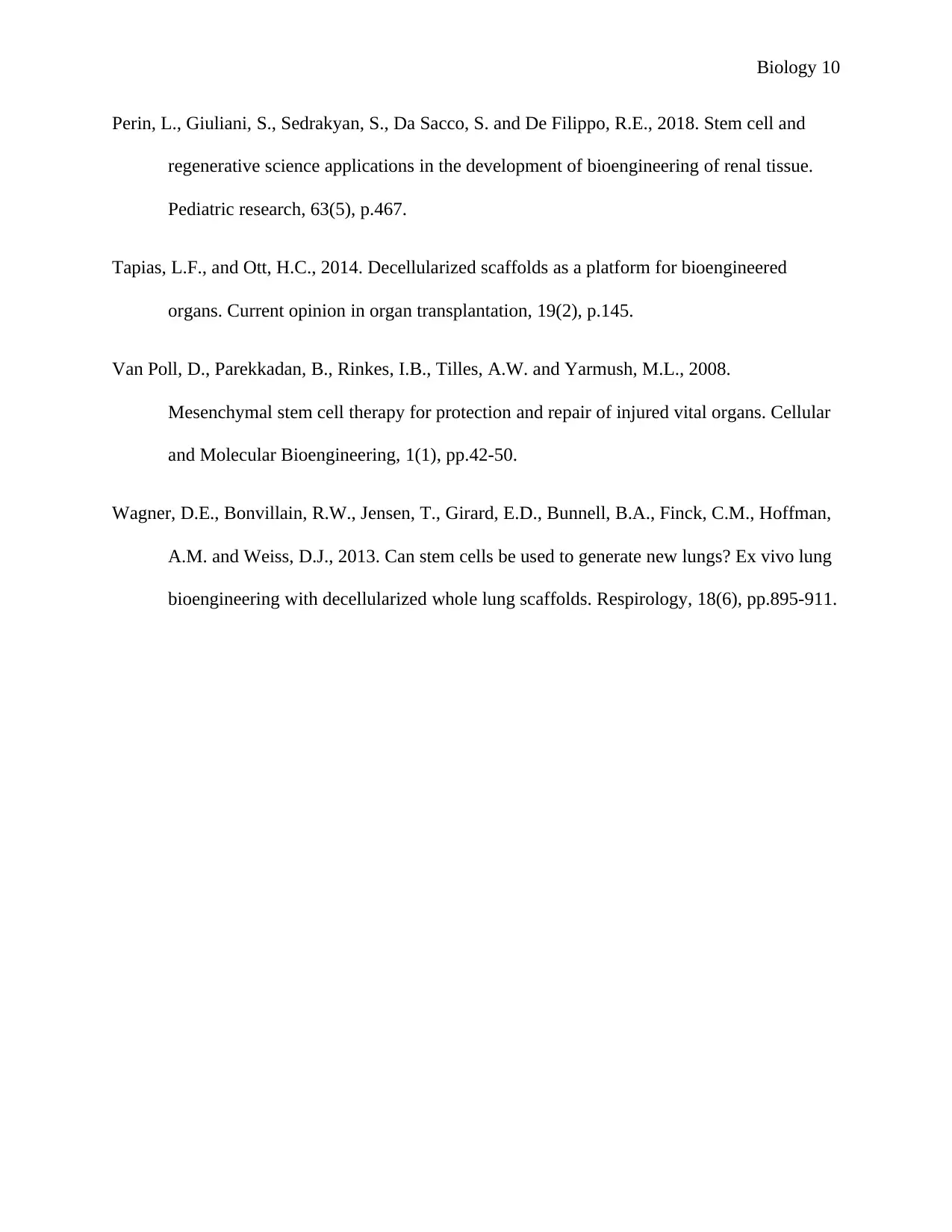
Biology 10
Perin, L., Giuliani, S., Sedrakyan, S., Da Sacco, S. and De Filippo, R.E., 2018. Stem cell and
regenerative science applications in the development of bioengineering of renal tissue.
Pediatric research, 63(5), p.467.
Tapias, L.F., and Ott, H.C., 2014. Decellularized scaffolds as a platform for bioengineered
organs. Current opinion in organ transplantation, 19(2), p.145.
Van Poll, D., Parekkadan, B., Rinkes, I.B., Tilles, A.W. and Yarmush, M.L., 2008.
Mesenchymal stem cell therapy for protection and repair of injured vital organs. Cellular
and Molecular Bioengineering, 1(1), pp.42-50.
Wagner, D.E., Bonvillain, R.W., Jensen, T., Girard, E.D., Bunnell, B.A., Finck, C.M., Hoffman,
A.M. and Weiss, D.J., 2013. Can stem cells be used to generate new lungs? Ex vivo lung
bioengineering with decellularized whole lung scaffolds. Respirology, 18(6), pp.895-911.
Perin, L., Giuliani, S., Sedrakyan, S., Da Sacco, S. and De Filippo, R.E., 2018. Stem cell and
regenerative science applications in the development of bioengineering of renal tissue.
Pediatric research, 63(5), p.467.
Tapias, L.F., and Ott, H.C., 2014. Decellularized scaffolds as a platform for bioengineered
organs. Current opinion in organ transplantation, 19(2), p.145.
Van Poll, D., Parekkadan, B., Rinkes, I.B., Tilles, A.W. and Yarmush, M.L., 2008.
Mesenchymal stem cell therapy for protection and repair of injured vital organs. Cellular
and Molecular Bioengineering, 1(1), pp.42-50.
Wagner, D.E., Bonvillain, R.W., Jensen, T., Girard, E.D., Bunnell, B.A., Finck, C.M., Hoffman,
A.M. and Weiss, D.J., 2013. Can stem cells be used to generate new lungs? Ex vivo lung
bioengineering with decellularized whole lung scaffolds. Respirology, 18(6), pp.895-911.
1 out of 10
Related Documents
Your All-in-One AI-Powered Toolkit for Academic Success.
+13062052269
info@desklib.com
Available 24*7 on WhatsApp / Email
![[object Object]](/_next/static/media/star-bottom.7253800d.svg)
Unlock your academic potential
Copyright © 2020–2025 A2Z Services. All Rights Reserved. Developed and managed by ZUCOL.





